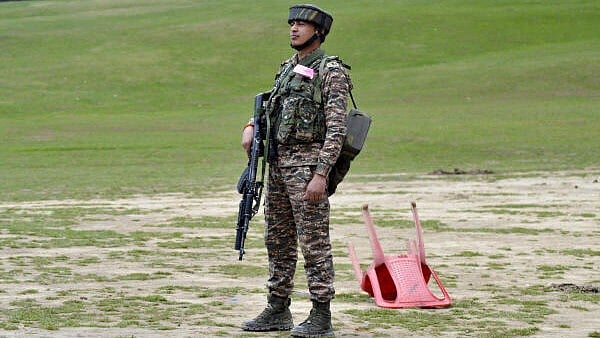
An Indian Army personnel at the site of the Pahalgam terror attack, in Anantnag district, Jammu and Kashmir on Wednesday
Credit: PTI Photo
New Delhi: The perpetrators of the Pahalgam terror attack planned the mass carnage carefully taking into account the fact that the forces from the nearby army and paramilitary camps may take more than an hour to reach the spot – enough time to disappear into the forest surrounding the meadows.
Sources familiar with the terrain said the troops from the closest Rashtriya Rifles unit would take about 40-45 minutes to reach the nearest road head from where they would have to trek for another 30-35 minutes to reach Baisaran, a popular picnic spot.
There is a Central Reserve Police Force camp ahead of the army establishment, but they would also take nearly an hour to reach.
“Those who planned the attack knew about the geography and prepared an escape route for the attackers. It is possible that they may have done a recce for a few days to see at what time the tourist flow is the maximum,” sources said.
The Indian Army troops and para-military personnel were conducting extensive searches in the area since the massacre, but the terrorists remained elusive so far.
The attack bears signatures of the involvement of Pakistan that has been using Lashkar-e-Taiba as a front to bleed India for years. The Resistance Force, a front of the LeT, took the responsibility.
“There is no doubt about Pakistan’s involvement. The Resistance Force is speaking Pakistan’s language. It also has local support. They attackers knew that such a site would give them time to carry out the act after checking on their religion. This may not have been possible elsewhere,” Lt Gen D P Pandey (rtd), former GOC of Indian Army’s 15 Corps in Srinagar told DH.
“Two Pakistani terrorists, assisted by two locals, unleashed the mayhem. While photos of the two Pakistani terrorists are available, the identities of the locals remain unknown,” sources said.
Officials note that there have been no prior intelligence inputs on the attack and nothing was picked up on radio chatter.
While there are now questions on the effectiveness of the four-tier security grid that is in operation in Jammu and Kashmir, officials also point out that because of increased tourist flow, it was not possible to bring back the restrictive measures that were in place earlier.
Sources said more than 120 Pakistani terrorists are currently active in Jammu and Kashmir, of which nearly 70 are in the valley while the rest is in the south of Pir Panjal. The number of local recruitment has come down from more than 120 in 2022 to less than 10 in 2024.
But the Pahalgam massacre would hit Kashmir's economy hard, opening up the possibility of money flow from across the border to win over the locals who would face the hardship, they added.
“While the state was peaceful and people were visiting, there was no peace in the minds of some (radical) people. Such radicalisation must go for a lasting peace,” said Lt Gen Pandey.
